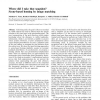Free Online Productivity Tools
i2Speak
i2Symbol
i2OCR
iTex2Img
iWeb2Print
iWeb2Shot
i2Type
iPdf2Split
iPdf2Merge
i2Bopomofo
i2Arabic
i2Style
i2Image
i2PDF
iLatex2Rtf
Sci2ools
BC
1998
1998
Where did I take that snapshot? Scene-based homing by image matching
In homing tasks, the goal is often not marked by visible objects but must be inferred from the spatial relation to the visual cues in the surrounding scene. The exact computation of the goal direction would require knowledge about the distances to visible landmarks, information, which is not directly available to passive vision systems. However, if prior assumptions about typical distance distributions are used, a snapshot taken at the goal suces to compute the goal direction from the current view. We show that most existing approaches to scene-based homing implicitly assume an isotropic landmark distribution. As an alternative, we propose a homing scheme that uses parameterized displacement ®elds. These are obtained from an approximation that incorporates prior knowledge about perspective distortions of the visual environment. A mathematical analysis proves that both approximations do not prevent the schemes from approaching the goal with arbitrary accuracy, but lead to dierent e...
| Added | 21 Dec 2010 |
| Updated | 21 Dec 2010 |
| Type | Journal |
| Year | 1998 |
| Where | BC |
| Authors | Matthias O. Franz, Bernhard Schölkopf, Hanspeter A. Mallot, Heinrich H. Bülthoff |
Comments (0)

